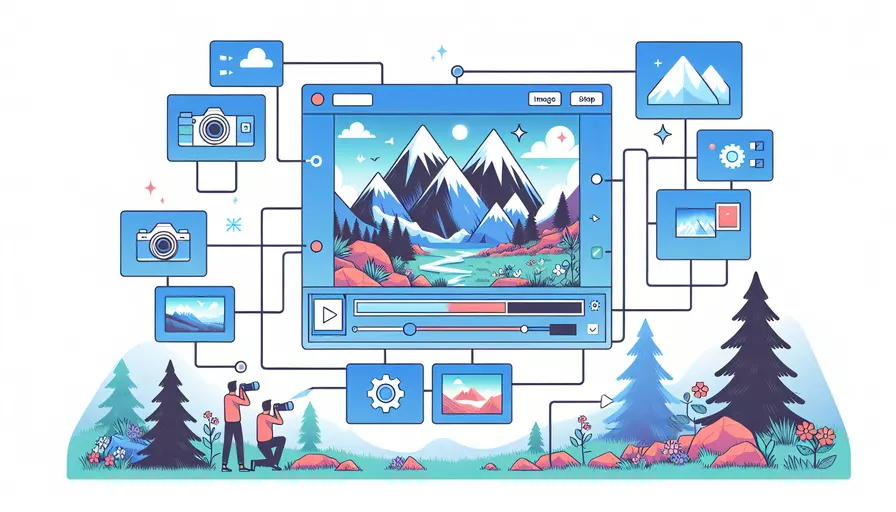
在Vue中设置图片铺满全屏可以通过1、使用CSS设置图片样式,2、使用背景图像两种方法来实现。以下是详细的步骤和解释。
一、使用CSS设置图片样式
- 创建Vue组件:
- 首先,我们需要创建一个Vue组件,并在模板中插入图片标签。
<template>
<div class="image-container">
<img src="path/to/your/image.jpg" alt="Full Screen Image">
</div>
</template>
<script>
export default {
name: 'FullScreenImage'
};
</script>
- 设置CSS样式:
- 使用CSS来确保图片在全屏显示时保持其比例并覆盖整个屏幕。
<style scoped>
.image-container {
position: fixed;
top: 0;
left: 0;
width: 100%;
height: 100%;
overflow: hidden;
z-index: -1; /* 确保图片在最底层 */
}
.image-container img {
width: 100%;
height: 100%;
object-fit: cover; /* 保持比例并覆盖整个容器 */
}
</style>
- 解释:
position: fixed;:固定定位,使图片相对于浏览器窗口固定。top: 0; left: 0; width: 100%; height: 100%;:使图片容器覆盖整个屏幕。overflow: hidden;:确保图片不会超出容器。z-index: -1;:使图片在最底层,不遮挡其他内容。object-fit: cover;:使图片保持比例并覆盖整个容器。
二、使用背景图像
- 创建Vue组件:
- 创建一个Vue组件,在模板中插入一个容器。
<template>
<div class="background-image"></div>
</template>
<script>
export default {
name: 'FullScreenBackground'
};
</script>
- 设置CSS样式:
- 使用CSS来设置背景图像。
<style scoped>
.background-image {
position: fixed;
top: 0;
left: 0;
width: 100%;
height: 100%;
background-image: url('path/to/your/image.jpg');
background-size: cover; /* 保持比例并覆盖整个容器 */
background-position: center; /* 确保图片居中 */
z-index: -1; /* 确保背景在最底层 */
}
</style>
- 解释:
background-image: url('path/to/your/image.jpg');:设置背景图像。background-size: cover;:保持图像比例并覆盖整个容器。background-position: center;:确保图像在容器中居中显示。
三、比较两种方法
| 方法 | 优点 | 缺点 |
|---|---|---|
| 使用CSS设置图片样式 | 1. 简单直接,适合需要操作具体img标签的场景。 | 1. 可能会影响页面的其他布局。 |
| 使用背景图像 | 1. 更灵活,不会影响页面其他元素的布局。 | 1. 不能直接操作图片标签,限制了图片的某些操作。 |
四、实例说明
假设我们有一个展示产品的网页,需要在背景放置一张全屏图片,可以选择使用背景图像的方法,这样不会影响到其他产品信息的展示。
<template>
<div class="product-page">
<div class="background-image"></div>
<div class="product-info">
<!-- 产品信息展示 -->
</div>
</div>
</template>
<script>
export default {
name: 'ProductPage'
};
</script>
<style scoped>
.product-page {
position: relative;
}
.background-image {
position: fixed;
top: 0;
left: 0;
width: 100%;
height: 100%;
background-image: url('path/to/your/product-image.jpg');
background-size: cover;
background-position: center;
z-index: -1;
}
.product-info {
position: relative;
z-index: 1;
/* 其他样式 */
}
</style>
五、总结和建议
在Vue中设置图片铺满全屏可以通过使用CSS设置图片样式和使用背景图像两种方法实现。使用CSS设置图片样式适合需要操作具体img标签的场景,而使用背景图像则更灵活,不会影响页面其他元素的布局。根据实际需求选择合适的方法,以确保页面布局和用户体验最佳。
建议在实现过程中注意图片的加载速度和性能优化,例如使用合适的图片格式和大小,确保页面加载速度和用户体验。
相关问答FAQs:
问题1:如何在Vue中设置图片铺满全屏?
要在Vue中设置图片铺满全屏,可以使用CSS样式来实现。下面是一种简单的方法:
- 首先,在Vue组件的样式中设置背景图片,并将其宽度和高度设置为100%:
<style>
.fullscreen-image {
background-image: url('your-image-url.jpg');
background-size: cover;
background-position: center;
width: 100%;
height: 100%;
}
</style>
- 在Vue组件的模板中添加一个具有fullscreen-image类的div元素:
<template>
<div class="fullscreen-image"></div>
</template>
这样,该div元素将会填满整个屏幕,并且背景图片会自动适应其大小。
问题2:如何在Vue中实现响应式的全屏图片?
如果你想要在Vue中实现响应式的全屏图片,可以使用Vue的计算属性和响应式样式。
- 首先,在Vue组件的计算属性中计算出当前屏幕的宽度和高度:
<script>
export default {
data() {
return {
screenWidth: 0,
screenHeight: 0
}
},
computed: {
fullscreenStyle() {
return {
backgroundImage: `url('your-image-url.jpg')`,
backgroundSize: 'cover',
backgroundPosition: 'center',
width: `${this.screenWidth}px`,
height: `${this.screenHeight}px`
}
}
},
mounted() {
this.screenWidth = window.innerWidth;
this.screenHeight = window.innerHeight;
window.addEventListener('resize', this.handleResize);
},
methods: {
handleResize() {
this.screenWidth = window.innerWidth;
this.screenHeight = window.innerHeight;
}
},
beforeDestroy() {
window.removeEventListener('resize', this.handleResize);
}
}
</script>
- 在Vue组件的模板中,使用计算属性中的fullscreenStyle作为div元素的样式:
<template>
<div :style="fullscreenStyle"></div>
</template>
这样,背景图片将会根据屏幕的大小自动调整,并保持铺满全屏。
问题3:如何在Vue中实现全屏幕滚动图片效果?
要在Vue中实现全屏滚动图片效果,可以使用一些插件或自定义动画库来实现。
- 使用Vue插件vue-fullpage.js:
首先,安装vue-fullpage.js插件:
npm install vue-fullpage.js
然后,在Vue组件中引入插件:
<script>
import VueFullpage from 'vue-fullpage.js';
export default {
components: {
VueFullpage
},
data() {
return {
images: ['image1.jpg', 'image2.jpg', 'image3.jpg']
}
}
}
</script>
最后,在Vue组件的模板中使用vue-fullpage组件,并遍历images数组来生成全屏滚动图片:
<template>
<VueFullpage>
<div v-for="image in images" :key="image" class="fullscreen-image" :style="{ backgroundImage: `url(${image})` }"></div>
</VueFullpage>
</template>
这样,你就可以实现全屏滚动图片效果了。
- 自定义动画库实现:
如果你想自定义全屏滚动图片效果,可以使用一些动画库,如Animate.css或TweenMax等。
首先,在Vue组件中引入动画库的CDN链接或将其安装为依赖项。
然后,在Vue组件的模板中使用动画库来实现全屏滚动图片效果。
例如,使用Animate.css库:
<template>
<div class="fullscreen-image animated" :class="animationClass" :style="{ backgroundImage: `url('your-image-url.jpg')` }"></div>
</template>
<style>
.animated {
animation-duration: 1s;
animation-fill-mode: both;
}
.fadeIn {
animation-name: fadeIn;
}
.fadeOut {
animation-name: fadeOut;
}
/* 定义其他动画效果 */
@keyframes fadeIn {
from {
opacity: 0;
}
to {
opacity: 1;
}
}
@keyframes fadeOut {
from {
opacity: 1;
}
to {
opacity: 0;
}
}
/* 定义其他动画效果 */
</style>
在Vue组件的Script部分,可以使用scroll事件监听滚动位置,并根据滚动位置来添加或删除动画类名:
<script>
export default {
data() {
return {
animationClass: ''
}
},
mounted() {
window.addEventListener('scroll', this.handleScroll);
},
methods: {
handleScroll() {
const scrollTop = window.pageYOffset || document.documentElement.scrollTop;
const windowHeight = window.innerHeight;
const elementOffsetTop = this.$el.offsetTop;
if (scrollTop > elementOffsetTop - windowHeight && scrollTop < elementOffsetTop + windowHeight) {
this.animationClass = 'fadeIn';
} else {
this.animationClass = 'fadeOut';
}
}
},
beforeDestroy() {
window.removeEventListener('scroll', this.handleScroll);
}
}
</script>
这样,当滚动到图片所在位置时,图片将会显示出动画效果。
文章标题:vue如何设置图片铺满全屏,发布者:worktile,转载请注明出处:https://worktile.com/kb/p/3638674

 微信扫一扫
微信扫一扫  支付宝扫一扫
支付宝扫一扫 